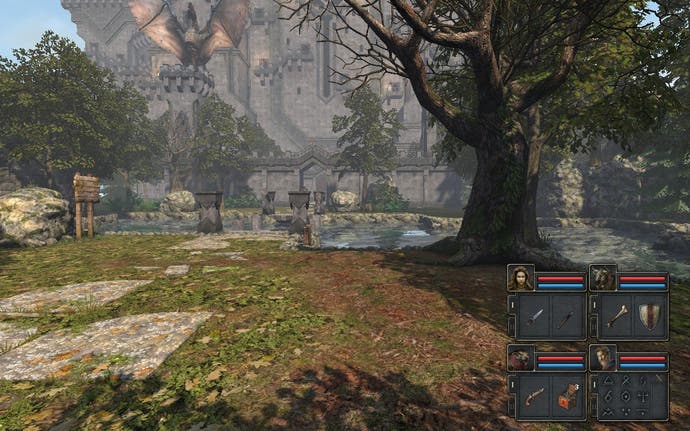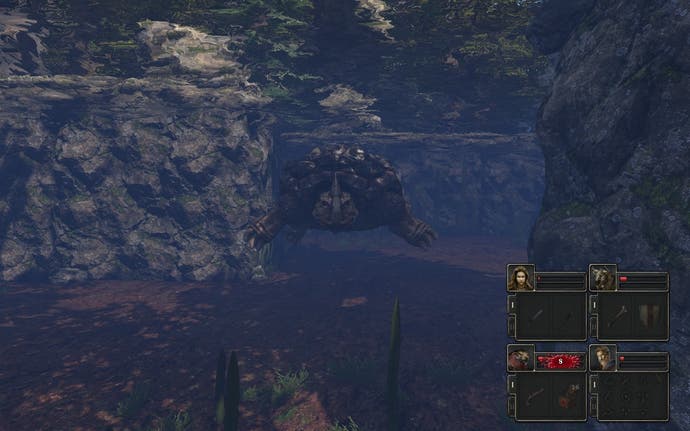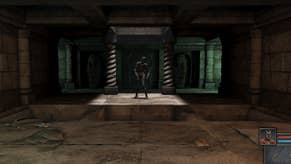Legend of Grimrock 2 review
Take it outside.
Perhaps the most impressive thing about Almost Human's sequel to its 2012 indie RPG hit is how confidently it strikes a balance between freedom and constraint. The most immediately obvious change is the switch from the gloomy interior of a mountain prison to a sun-kissed, but no less sinister island.
For anyone who played the original, the aesthetic difference is impossible to miss. As you begin your adventure, locked in a cage on a beach, the presence of a blue sky above you and the distant horizons have an invigorating effect. This is a place that invites exploration. Yet Almost Human has wisely resisted the lure of the sandbox. You're still restricted to the same old school grid pattern as before, the world built around the same reliable graph paper boxes that drove stylistic predecessors such as Eye of the Beholder. Often the game conspires to force you down narrow corridors, formed by trees or rocks as well as actual stone walls, but it also opens out when needed, into spacious clearings. It's an environment at once expansive and focussed.
A similar canny balancing act plays out in Grimrock 2 at every level, resulting in a sequel that improves its template across the board without falling foul of the easy design trap of cramming in new features. In 2012, Almost Human intimately understood the style of game it wanted to resurrect and it hasn't allowed success to bloat that vision.

So, once again, you find yourself controlling a quartet of characters - either hand crafted by the player or assigned at random. They move together, one square at a time, with melee fighters up front and the spell casting wizard and range-attacking, potion-crafting alchemist taking the rear.
Control is simple and intuitive. Click on objects in the world to pick them up. Drop them into the open hand slots of the character windows, or place them in their inventories. Right clicking uses items and weapons. It's the same system you use to interact with files and programs on your PC, so virtually anything you want to do in the game is done how you'd expect. Rare is the situation where you need to turn to the instructions for help navigating the game's systems.
You will, however, need help navigating the island itself, which is both larger and more complex than the Grimrock dungeons of old. Partly this is an idea sold through the greater visual variety made possible by the outdoors locations, as you trek from beach to forest to swamps and beyond, but it's true at a structural level as well. The first game was great, though it was contained and largely linear. Now, Grimrock spreads in multiple directions at once, and reckless players who charge ahead, filling in as much of the automap as they can, will easily find themselves overwhelmed.
Far better to take things slowly, progress methodically, and take advantage of the map's note-taking functions to remind yourself of what each locked door and blocked passage might require to pass. You'll encounter the expected menagerie of creatures as you go, and dust off those side-stepping, back-shuffling combat muscles in the process, but battling in Grimrock - as in any great role-player - is ultimately just a means to an end.

The XP earned for each victory is essential, of course, in developing the skill trees of your characters and opening up more possibilities, but the nutty, chewy heart of the game is spatial rather than martial in nature. It's about getting to places - getting past that gate, getting through that trap, getting your head around those puzzles.
Ah, the puzzles. They're what really make this series stand out, and they're also where the subtle yet powerful evolution of Grimrock 2 is most evident. These are genuine head scratchers, of the sort that would once have added muscle to hardcore point and click adventure games. Some are mechanical in nature, requiring you to work out the function of some stone and steel contraption. Others are entirely cerebral, tasking you with cracking codes rather than skulls. Sometimes the solution requires nothing but ruthless logic, sometimes lateral thinking and unlikely inspiration is what clears the path ahead. Only occasionally does the answer feel like a cheat; for the most part these are perfect examples of how to challenge the player's brain, with solutions that seem impenetrable for so long, before becoming entirely obvious in the glare of a victorious lightbulb moment.
Pacing is also improved from the previous game, with a steadier escalation of both monster encounters and puzzle difficulty. There are still dead ends aplenty, but few that will leave you with nowhere else to go. That doesn't mean the game is easier, or that casual players will be led by the hand to the end, but that there's a much more nuanced interplay between frustration and progress. You need the former to make the latter work, but even if you find yourself stymied by one door, you'll find pockets of elation from other, smaller discoveries and victories as you root around. More than once, backtracking for inspiration, I found chests, items and levers in areas that I swore I'd picked clean.

It's the sort of game that demands complete submission - you either surrender and sink into its depths, or you'll glance off its somewhat cold and stony exterior and be left wondering what the fuss is about. Making that transition easier is a greater emphasis on presentation, with graphics that take full advantage of being freed from gloomy stone passageways and shambling monsters. Those still crop up, in several jaunts into underground caves and ruins, but now they're a chilling change of pace rather than a claustrophobic marathon. There are scenes here that are epic in comparison to what came before and, even through the rigid grid-based movement, Almost Human reveals them to the player in ways that will widen your eyes and lift your pulse. The allure of finding somewhere new never loses its shine.
We're so conditioned to expect sequels to cram in more features in an attempt to be noticeably different, but there's a quiet confidence to Grimrock 2 that is utterly beguiling. Bigger, bolder and utterly sure of itself and its intended audience, Almost Human may be looking to the past for inspiration, but it's created one of the best pure role-playing games of the year.










